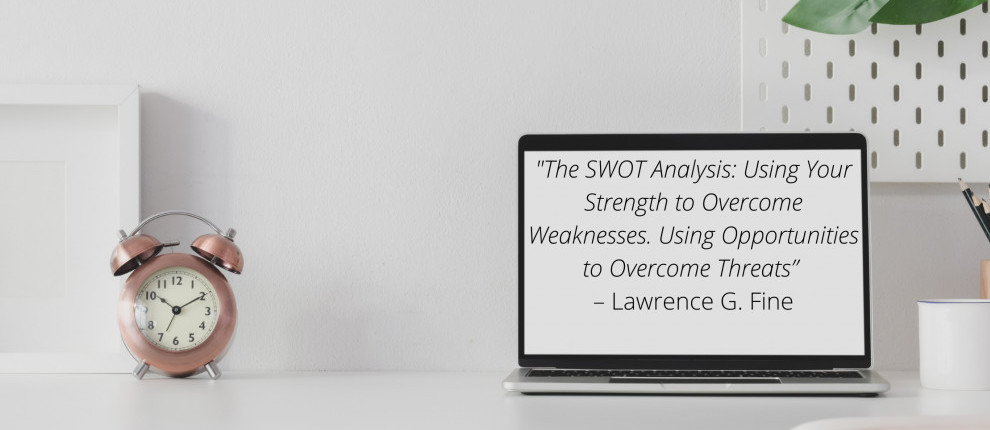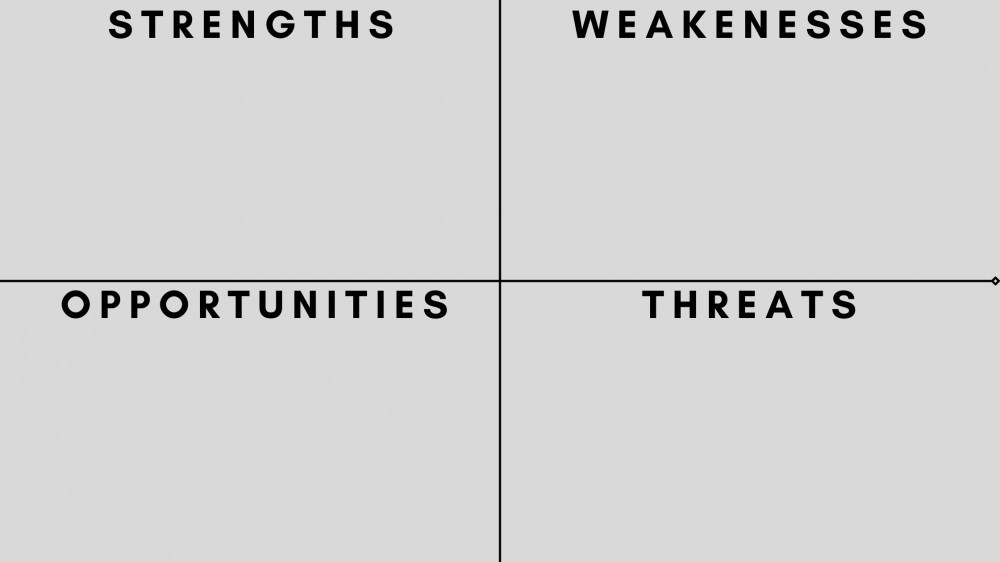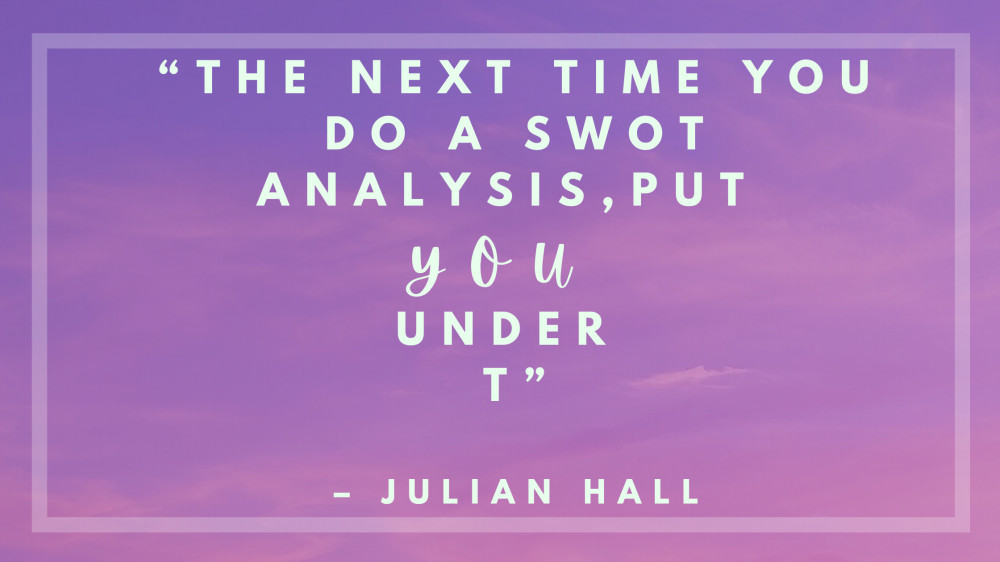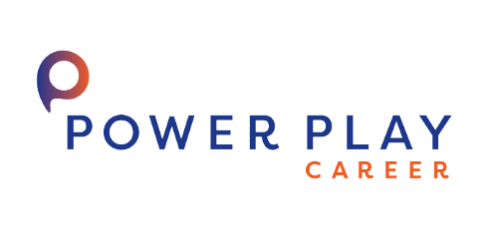
What do you consider to be your greatest strength? What would you say is your biggest weakness? Do you dread these questions in interviews? You are not alone. Of course, being well-prepared to answer these questions in an interview is a must, however, it does go beyond that. Being clear on the value you bring, your accomplishments, as well as your strengths and weaknesses can help you to reach new heights and get you closer, to your career goals faster.
It is important to always be thinking about your career and continue to put as much work into your career development as you would in an interview. You should always be looking at your career as a business of one and as such, conduct a SWOT analysis of your career positioning.
The SWOT Analysis technique is credited to Albert Humphrey, a management consultant, specializing in organizational management and cultural change, and is used traditionally by a number of organizations. In this post, I would like to show you how you can use this tool on a more personal level.
Here are some examples of when Personal SWOT Analysis can be useful in career development:
1. When preparing for a job interview
2. When applying for a promotion
3. When making a career change
4. When creating a personal brand
5. When setting goals
6. And many more
It can also be used in other ways to improve your life, relationships or business by allowing you to examine your life from a different point of view and to evaluate the actions you can take to enjoy your best life.
In this post, our focus will be on setting goals at work in each quarter and giving you a systematic approach to looking at your career development.
When it comes to identifying your strengths, you might feel humbled. It is the most dreaded question in an interview after: “what are your weaknesses?” Unfortunately, most of us don’t take the time to really know our unique selves and genuinely understand our strengths and weaknesses. In this post, I will focus on “strengths”.
Understanding our strengths and weaknesses will help you use your talents, skills and unique abilities to their fullest extent and to put them to good use, especially in a new job. It will also help you uncover the opportunities that you may not have seen and help to eliminate some threats to moving forward.
Why should you take the time to do an analysis?
It gives you structure and data to achieve your goals and carry out informed planning.
There are many self-assessments, tests, and worksheets available to help you identify your strengths, and today I will talk about the Personal SWOT analysis. SWOT is an acronym for strengths, weaknesses, opportunities, and threats. This framework is usually used in a business setting, however, I would like to show you how to use it personally to assess your abilities as an individual.
Strengths and weaknesses centre around internal factors, such as pre-existing competencies or skills we do not yet possess.
In contrast, opportunities and threats regard external factors in our environments that may facilitate our ability to put our strengths to use or threaten to expose our weaknesses.
This is a great tool to develop a career plan that takes advantage of your strengths and opportunities and improves your weaknesses while at the same time helping you to avoid threats.
This tool is very simplistic and is a great way to get you started. It may not appear to be helpful by itself, but it can become more valuable combined with other strategic planning methods.
To perform a personal SWOT, divide a paper into four quadrants (each for strengths, weaknesses, threats, and opportunities).

The first step is brainstorming by asking a series of questions. Always start with strengths.
To get a sense of how to conduct a Personal SWOT Analysis, take a look at some of these example questions to prompt your thinking about each letter in the SWOT acronym:
STRENGTHS (go ahead, brag a little or a lot)
· What are you naturally good at?
· What are your skills, talents?
· What are your unique gifts or superpowers?
· What values are unique to you?
· How do your education, certifications, etc., set you apart from your peers?
· What are your values or ethics?
WEAKNESSES (be brutally honest here)
· What are the tasks you avoid or procrastinate doing?
· What, in your opinion, are you not good at?
· What are the things about your personality or habits that may be holding you back?
· What are your bad habits?
· Where are your education, training, or skills lacking?
OPPORTUNITIES
· Is your job in a growing industry?
· What is your impact, and how can you take advantage of it?
· Is your company failing to do something? (From your perspective as a new employee)
· How could new technology help you advance?
· How could your connections help you?
THREATS
· What barriers do you currently face in your career?
· Who is your competition?
· Is today’s technology a threat to your current position?
· Do you feel threatened by your weaknesses?
Strengths
What am I good at?
Skills, education, talents.
Opportunity
What happens next?
Progression in career
Places for growth
Weaknesses
What am I not so good at?
Feedback from others.
Threats
Where can this go wrong?
New colleague, economic downward trend
Example
One of your strengths is learning and managing from a gut feel. You have identified a threat as data-driven decision-making, which requires you to be good at numbers. Now you can match that threat back to your strength by learning how to make better decisions based on numeric data, thus turning the threat into an opportunity. Use your strengths to transform threats into opportunities. Now you can create an action list with S.M.A.R.T. Specific, Measurable, Attainable, Relevant, Time-bound.

Ok, so now what? What do you do with all this information?
You can use the strengths that you have identified and match them with some of the opportunities that you have listed. You can also tie your weaknesses with your threats and uncover situations you should avoid. Another way is to use this information to convert your weaknesses into strengths and sometimes threats into opportunities by creating an action plan.
Here’s an example from Indeed:
Personal SWOT analysis example
Cleo just graduated from college and wants to create a SWOT analysis before searching for personal trainer positions. Here are the sections of her personal SWOT analysis:
Strengths
- Bachelor’s Degree in Sports Medicine
- NASM Certified Personal Trainer
- College internship with a local health and fitness center
- Passion for helping clients
Weaknesses
- Difficulty developing training plans for swimmers
- Finds it challenging to compete for clients
- Limited sales and marketing experience
Opportunities
- Offer a variety of training sessions
- Attend a sales or marketing workshop
- Attend specialized training courses
- Room for career advancement
Threats
- Competition among other personal trainers in the area for clients
- Others may be more confident with the sales aspect
Cleo now has a SWOT list she can review to decide how she can boost her job search. She has the education and certification to be a personal trainer, but her main challenges are sales and signing new clients. If she wants to pursue as many opportunities as possible, she can take a sales workshop to improve her skills. She may avoid sales by working for a gym that assigns new clients to personal trainers, but it would limit her job search opportunities.
After carefully reviewing her analysis, Cleo proceeds to search for all available opportunities. Learning a new skill can help her long-term success. So she signs up for an online sales class to gain more knowledge while she searches, and she lists it on her resume.
From SWOT TO TOWS
Suppose you want to take your analysis further to create strategies and plans for career progression. Then, TOWS (SWOT backwards) shows you the connections between each quadrant by combining two quadrants to develop actionable objectives.
Opportunities
(external, positive)
Threats
(external, negative)
Strengths
(internal, positive)
Strength-Opportunity
Use your internal strengths to take advantage of opportunities
Strength-Threats strategies
Use your strengths to minimize threats.
Weaknesses
(internal, negative
Weakness-Opportunity strategies
Improve weaknesses by taking advantage of opportunities.
Weakness-Threats strategies
Work to eliminate weaknesses or turn them into strengths to avoid threats
You can now form actionable steps from your answers.
Planning each quarter (or every 90 days) could bring your professional game up by including a review of your Personal Swot Analysis. Take your action objectives, break them down into micro-steps, and add them to your calendar or task list. Now that you have created your career development resource, keep it handy and review it weekly as you plan out your week.
Conclusion
If this is the first time hearing about SWOT Analysis, keep in mind, you can also conduct a SWOT Analysis by evaluating your company, department, or project. Have you run a SWOT Analysis before? What about a personal one? Any surprises? Did your life improve? What was a significant step you took after completing the analysis? I would love to hear from you with any insights or observations you may have – drop me a comment below.
If you would like guidance planning your next quarter or career development to create a life you love, I’m here to help.
“If you work on your job, you make a living; if you work on yourself, you’ll make a fortune.” – Jim Rohn
Your devotee
Joanne Savoie-Malone


Hello there! This is a helpful post. I have learned about the SWOT analysis before a long while back when I was still in school. It really helps puts things into perspective from what I remember and helps one makes decisions such as career decision making. But it’s been a while and I don’t remember too much. After reading your article, I am reminded about how powerful a tool this can be. I think I will be using it more often especially for the small projects. Thanks for the reminder.
Thank you, Mike, I appreciate your comments, and I’m happy to hear that it has inspired you to use the tool. Wishing you all the best!
SWOT analysis is definitely a great way to do a little bit of introspection before a job interview, promotion, or any big life changing decision really. It’s a really great tool that I learned back in Career Development class back in High School to really help you be more mindful of where you currently are and what you need to overcome to meet your goals. I never heard of trying to do the analysis backwards and compare the two however, but that’s definitely a great thing to know as well.
Thank you, Rachel, for your comments. Yes, doing the analysis backyard can be powerful especially to form your actionable steps.
Thank you for interesting article. I heard before about SWOT analysis during the studies but to be fair never thought about it too much. But looking on your post it seems as a powerful tool which may be very helpful to assess and develop our career and business. Looking forward to use your advices in practice and create my own SWOT analysis.
Thank you Cogito. People tend to want the complicated gadgets when simplicity can be powerful. Let me know how it goes with your Personal SWOT Analysis.